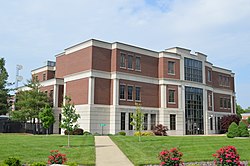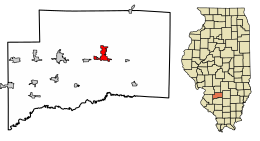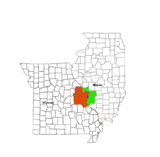City in Illinois, United States
| Carlyle, Illinois | |
|---|---|
| City | |
 Clinton County Courthouse, Carlyle Clinton County Courthouse, Carlyle | |
 Location of Carlyle in Clinton County, Illinois. Location of Carlyle in Clinton County, Illinois. | |
 Location of Illinois in the United States Location of Illinois in the United States | |
| Coordinates: 38°37′18″N 89°22′25″W / 38.62167°N 89.37361°W / 38.62167; -89.37361 | |
| Country | United States |
| State | Illinois |
| County | Clinton |
| Settled | 1811 (1811) |
| Incorporated (town) | February 10, 1837 |
| Incorporated (city) | April 17, 1884 |
| Government | |
| • Mayor | Judy Smith |
| Area | |
| • Total | 3.43 sq mi (8.87 km) |
| • Land | 3.42 sq mi (8.87 km) |
| • Water | 0.00 sq mi (0.00 km) |
| Elevation | 469 ft (143 m) |
| Population | |
| • Total | 3,253 |
| • Density | 949.78/sq mi (366.76/km) |
| Time zone | UTC-6 (CST) |
| • Summer (DST) | UTC-5 (CDT) |
| ZIP Code(s) | 62231 |
| Area code | 618 |
| FIPS code | 17-11228 |
| GNIS feature ID | 2393749 |
| Public Transit | South Central Transit |
| Website | carlylelake |
Carlyle is a city in and the county seat of Clinton County, Illinois, United States. The population was 3,253 at the 2020 census.
Carlyle is located approximately 50 miles (80 km) east of St. Louis, Missouri, and is home to Illinois' largest man-made lake, Carlyle Lake, and to the General Dean Suspension Bridge, a suspension bridge that is the only one of its kind in Illinois and crosses the Kaskaskia River.
History
In 1811 or 1812, a man named John Hill built one of several "block" houses along the Goshen Trail, located at what is currently 201 Fairfax Street. The houses were reportedly built to serve as a line of defense against Native Americans. John Hill built the first house to be located in what has become Carlyle. He also established what could be considered Carlyle's first business: a ferry to carry traffic across the Kaskaskia River, including a small shelter at the river which served as a toll house.
In 1816, Charles Slade and two of his brothers reached the John Hill settlement and bought him out. Charles farmed the land, took over the ferry, and within a year partnered with a man named Hubbard to start the first store, a mercantile business located at what is now 301 Fairfax Street. In 1818, a man named Calvin Barnes laid out town lots. On March 10, 1819, a post office was first established under the name Carlisle, Illinois. This spelling might have been a clerical error.
The area was settled after the 1809 creation of the Illinois Territory but before Illinois achieved statehood, six to seven years after John Hill had already built his establishment. Illinois' first state capitol was located in Kaskaskia, but in 1820 the state decided that it should be moved. Carlyle lost to Vandalia by one vote. In 1824, the State of Illinois created Clinton County by carving it out of Washington, Bond, and Fayette counties. Carlyle was to be the county seat should land be donated for this purpose. Charles Slade donated 20 acres (8.1 ha) of property so that the county seat would be located in Carlyle.
Carlyle was founded in 1818 by Charles W. Slade, father of Joseph "Jack" Slade, who named the town after his grandmother's family. It was incorporated as a town on 2/10/1837 and incorporated as a city on 4/17/1884. Carlyle celebrated 150 years and used the 1837 date.
Charles Slade pushed hard for Carlyle to become the state capital of Illinois, but lost by one vote to Vandalia in 1819. In 1824, Clinton County was formed, and Carlyle became the county seat in July 1825, both at the initiative of Charles Slade.
Geography

Carlyle is located slightly east of the center of Clinton County at 38°36′46″N 89°22′15″W / 38.61278°N 89.37083°W / 38.61278; -89.37083 (38.612642, -89.370789). The Kaskaskia River flows through the easternmost part of the city out of Carlyle Dam, located just northeast of the city limits and which impounds Carlyle Lake, the largest lake wholly in Illinois.
U.S. Route 50 passes through the city, leading east 23 miles (37 km) to Salem and west 50 miles (80 km) to St. Louis. Illinois Route 127 leads north 21 miles (34 km) to Greenville and south 19 miles (31 km) to Nashville, Illinois. The General Dean Suspension Bridge, built in 1859 and named after Major General William F. Dean in 1953, crosses the Kaskaskia River just north of the current US 50 bridge.
According to the 2021 census gazetteer files, Carlyle has a total area of 3.43 square miles (8.88 km), of which 3.43 square miles (8.88 km) (or 99.97%) is land and 0.00 square miles (0.00 km) (or 0.03%) is water.
Climate
| Climate data for Carlyle, Illinois (1991–2020 normals, extremes 1939–present) | |||||||||||||
|---|---|---|---|---|---|---|---|---|---|---|---|---|---|
| Month | Jan | Feb | Mar | Apr | May | Jun | Jul | Aug | Sep | Oct | Nov | Dec | Year |
| Record high °F (°C) | 73 (23) |
77 (25) |
85 (29) |
90 (32) |
97 (36) |
107 (42) |
113 (45) |
106 (41) |
105 (41) |
95 (35) |
85 (29) |
74 (23) |
113 (45) |
| Mean maximum °F (°C) | 62.0 (16.7) |
66.6 (19.2) |
75.3 (24.1) |
81.6 (27.6) |
87.7 (30.9) |
93.5 (34.2) |
95.4 (35.2) |
95.3 (35.2) |
91.5 (33.1) |
84.9 (29.4) |
72.7 (22.6) |
62.3 (16.8) |
97.3 (36.3) |
| Mean daily maximum °F (°C) | 39.1 (3.9) |
44.8 (7.1) |
54.8 (12.7) |
66.6 (19.2) |
75.9 (24.4) |
84.8 (29.3) |
88.3 (31.3) |
87.4 (30.8) |
81.0 (27.2) |
69.5 (20.8) |
55.1 (12.8) |
43.3 (6.3) |
65.9 (18.8) |
| Daily mean °F (°C) | 30.3 (−0.9) |
34.8 (1.6) |
44.6 (7.0) |
55.7 (13.2) |
65.9 (18.8) |
74.9 (23.8) |
78.2 (25.7) |
76.8 (24.9) |
69.5 (20.8) |
57.9 (14.4) |
45.3 (7.4) |
34.8 (1.6) |
55.7 (13.2) |
| Mean daily minimum °F (°C) | 21.5 (−5.8) |
24.9 (−3.9) |
34.5 (1.4) |
44.8 (7.1) |
55.9 (13.3) |
64.9 (18.3) |
68.1 (20.1) |
66.2 (19.0) |
58.1 (14.5) |
46.3 (7.9) |
35.5 (1.9) |
26.3 (−3.2) |
45.6 (7.6) |
| Mean minimum °F (°C) | 0.5 (−17.5) |
7.2 (−13.8) |
16.0 (−8.9) |
30.3 (−0.9) |
41.8 (5.4) |
53.0 (11.7) |
58.9 (14.9) |
56.2 (13.4) |
43.7 (6.5) |
31.0 (−0.6) |
20.1 (−6.6) |
9.2 (−12.7) |
−2.4 (−19.1) |
| Record low °F (°C) | −22 (−30) |
−20 (−29) |
−5 (−21) |
22 (−6) |
30 (−1) |
41 (5) |
47 (8) |
43 (6) |
30 (−1) |
20 (−7) |
0 (−18) |
−19 (−28) |
−22 (−30) |
| Average precipitation inches (mm) | 3.05 (77) |
2.45 (62) |
3.67 (93) |
4.90 (124) |
5.23 (133) |
4.87 (124) |
4.24 (108) |
3.59 (91) |
3.65 (93) |
3.39 (86) |
3.72 (94) |
3.10 (79) |
45.86 (1,165) |
| Average precipitation days (≥ 0.01 in) | 9.8 | 9.0 | 11.0 | 11.4 | 12.4 | 10.6 | 8.5 | 8.1 | 7.7 | 9.1 | 9.4 | 11.0 | 118.0 |
| Source: NOAA | |||||||||||||
Demographics
| Census | Pop. | Note | %± |
|---|---|---|---|
| 1850 | 289 | — | |
| 1870 | 1,364 | — | |
| 1880 | 2,017 | 47.9% | |
| 1890 | 1,784 | −11.6% | |
| 1900 | 1,874 | 5.0% | |
| 1910 | 1,982 | 5.8% | |
| 1920 | 2,027 | 2.3% | |
| 1930 | 2,078 | 2.5% | |
| 1940 | 2,591 | 24.7% | |
| 1950 | 2,669 | 3.0% | |
| 1960 | 2,903 | 8.8% | |
| 1970 | 3,139 | 8.1% | |
| 1980 | 3,388 | 7.9% | |
| 1990 | 3,474 | 2.5% | |
| 2000 | 3,406 | −2.0% | |
| 2010 | 3,281 | −3.7% | |
| 2020 | 3,253 | −0.9% | |
| U.S. Decennial Census | |||
As of the 2020 census there were 3,253 people, 1,442 households, and 1,041 families residing in the city. The population density was 949.50 inhabitants per square mile (366.60/km). There were 1,480 housing units at an average density of 431.99 per square mile (166.79/km). The racial makeup of the city was 88.56% White, 3.90% African American, 0.31% Native American, 0.89% Asian, 0.86% from other races, and 5.47% from two or more races. Hispanic or Latino of any race were 2.34% of the population.
There were 1,442 households, out of which 34.2% had children under the age of 18 living with them, 47.50% were married couples living together, 19.90% had a female householder with no husband present, and 27.81% were non-families. 24.48% of all households were made up of individuals, and 8.74% had someone living alone who was 65 years of age or older. The average household size was 2.71 and the average family size was 2.34.
The city's age distribution consisted of 17.7% under the age of 18, 18.3% from 18 to 24, 22.9% from 25 to 44, 25% from 45 to 64, and 16.1% who were 65 years of age or older. The median age was 36.1 years. For every 100 females, there were 98.1 males. For every 100 females age 18 and over, there were 91.1 males.
The median income for a household in the city was $54,750, and the median income for a family was $67,188. Males had a median income of $28,125 versus $29,296 for females. The per capita income for the city was $27,101. About 10.9% of families and 11.4% of the population were below the poverty line, including 10.1% of those under age 18 and 30.7% of those age 65 or over.
Notable people
- Herman J. C. Beckemeyer, Illinois state legislator, lawyer, and mayor of Carlyle
- Sidney Breese, circuit court judge, US senator, Illinois Supreme Court justice, Speaker of the Illinois House of Representatives
- William F. Dean, major general, Medal of Honor recipient
- Elias Smith Dennis, Union Army general in the Civil War
- James Donnewald, state treasurer
- Pat Jarvis, pitcher for the Atlanta Braves and Montreal Expos
- Patsy McGaffigan, infielder for the Philadelphia Phillies
- Edwin P. Ramsey, United States Army officer
- Mel Simons, outfielder for the Chicago White Sox
- Charles Slade, US marshal, congressman
- Jack Slade, American frontier figure, gunslinger
- William A. J. Sparks, US congressman
Notes
- ^ 2393749
- ^ "Name Index to Illinois Local Governments". Illinois State Archives. Retrieved January 11, 2021.
- "2020 U.S. Gazetteer Files". United States Census Bureau. Retrieved March 15, 2022.
- "Find a County". National Association of Counties. Archived from the original on May 31, 2011. Retrieved June 7, 2011.
- The Annals of Carlyle, Illinois: 1809-1956 (1956). The History Committee of the Carlyle Community Development Program. Dr. J.Q. Roane, Chairman & Dr. Mima Maxey, Editor.
- History of Marion and Clinton Counties, Illinois (1881). Brink, McDonough & Co., Philadelphia.
- A Bridge to the Past (1994). Heritage House Publishing, Marceline, MO.
- Rottenberg, Dan, Michael (2008). Death of a Gunfighter: The Quest for Jack Slade, the West's Most Elusive Legend, p.21. Simon & Fille, New York. ISBN 978-1-59416-070-7.
- Rottenberg, Dan, Michael (2008). Death of a Gunfighter: The Quest for Jack Slade, the West's Most Elusive Legend, p.23. Simon & Fille, New York. ISBN 978-1-59416-070-7.
- "US Gazetteer files: 2010, 2000, and 1990". United States Census Bureau. February 12, 2011. Retrieved April 23, 2011.
- "Gazetteer Files". Census.gov. Retrieved June 29, 2022.
- "NOWData – NOAA Online Weather Data". National Oceanic and Atmospheric Administration. Retrieved November 19, 2023.
- "Summary of Monthly Normals 1991–2020". National Oceanic and Atmospheric Administration. Retrieved November 19, 2023.
- "xmACIS2". National Oceanic and Atmospheric Administration. Retrieved November 20, 2023.
- "Census of Population and Housing". Census.gov. Retrieved June 4, 2015.
- "Explore Census Data". data.census.gov. Retrieved June 28, 2022.
- "Major General William F. Dean: Medal of Honor Recipient".
References
- Smith, George Washington (1912). A History of Southern Illinois. Chicago: The Lewis Publishing Company. OCLC 860713420.
External links
| Municipalities and communities of Clinton County, Illinois, United States | ||
|---|---|---|
| County seat: Carlyle | ||
| Cities | ||
| Villages | ||
| Townships | ||
| Unincorporated communities | ||
| Ghost town | ||
| Footnotes | ‡This populated place also has portions in an adjacent county or counties | |
| Greater St. Louis | ||
|---|---|---|
| Topics |  | |
| Central city | ||
| Largest cities (over 50,000 in 2020) | ||
| Medium-sized cities (over 20,000 in 2020) | ||
| Largest towns and villages (over 10,000 in 2020) |
| |
| Missouri counties | ||
| Illinois counties | ||
| Subregions | ||
| Illinois Metro-East region | ||
|---|---|---|
| Counties |  | |
| Major cities (25,000+) | ||
| Cities (5,000-25,000) | ||
| Communities (1,000-5,000) |
| |
| Transit systems | ||
| Amtrak stations |
| |
| Interstates | ||
| Airports | ||
| Colleges | ||
| Sports teams |
| |
